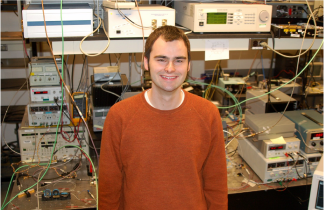 (Left: Data points from Osram Opto Semiconductor of Germany. Lower black square at 142 lm/W demonstrating record white-light LED efficiency; second black square at 160 lm/W shows projected efficiency after further optimization.)
(Left: Data points from Osram Opto Semiconductor of Germany. Lower black square at 142 lm/W demonstrating record white-light LED efficiency; second black square at 160 lm/W shows projected efficiency after further optimization.)You may not think that LED lighting would be a controversial topic, but as the New York Times reports, it may be indirectly responsible for new anger among conservative lawmakers in the United States. A U.S. federal law passed in 2007 by the Bush administration will, among other energy-saving measures, make the sale of the incandescent 100-watt light bulbs illegal in 2012. Republican representatives Joe Barton of Texas and Michelle Bachmann of Minnesota, and Republican Senator Rand Paul of Kentucky have recently become vocal about the rights of Americans to purchase lighting of their choice (energy-efficient or not).
The alternatives to the more-than-a-century-old technology spurning this debate are a new make-over of halogens (not much more efficient than incandescent bulbs at about 20 lumens/W), compact fluorescent bulbs (about70 lumens/W), and LED lighting (Osram Opto Semiconductors of Germany just recently claimed to have set a record for warm-white LED chips at 142 lumens/W). CLEO attendees beware: might tea-party members be planning protests of sessions within CLEO Science and Innovation 15: LEDs, Photovoltaics and Energy-efficient ("green") Photonics?
The "controversial" talks related to LED lighting can be found specifically in sessions "Nano-structured LEDs" on Monday, May 2, 1:30-3:15 pm and "Toward More Efficient Visible LEDs" on Wednesday, May 4, 1:30-3:10 pm. Many of these talks will address specific problems in the overarching goal of fabricating highly-efficient LEDs that can simultaneously mimic the white-light spectrum of an incandescent light bulb. White-light LEDs could reach luminous efficiencies of greater than 300 lumens/W once certain device and fabrication challenges are overcome.1
One of the greater challenges is overcoming the emission gap in the green-yellow region of the visible spectrum (515-600 nm).1,2 Whether multiple LEDs of different color are combined to produce white-light, or one or two different colored LEDs are used to pump phosphors to produce white light, current designs lack efficient production of yellow-green photons for true white-light color (a stinging irony for a technology slated as "green" photonics). Invited talk, CMU5, "Nitride-based Nano-columns and Applications" and contributed paper CMU6, "Diffraction-Coupled Plasmon-Enhanced Light Emission from InGaN/GaN Quantum Wells" in session "Nano-structured LEDs"will show different approaches to generating green light using nano-structures on InGaN. Lowering the dimensionality by using nano-structures allows one to play with defect, strain, and polarization properties of the material and hence light generating capability and extraction.2
Another challenge being addressed in session "Toward More Efficient Visible LEDs" is "efficiency droop" particular to InGaN. InGaN LEDs show great promise at low currents, but suffer an enormous efficiency reduction (the droop) at high-current injection, a problem for potential use in high-power applications. The jury is still out on the cause for the droop.2 Contributed paper CWF3, "On the symmetry of efficiency-versus-carrier-concentration curves in GaInN/GaN light-emitting diodes and relation to droop-causing mechanisms" will be presenting evidence in support of carrier-leakage theory for droop. Contributed paper CWF4 "Efficiency Droop Reduction in InGaN/GaN Light-emitting Diodes by Graded-thickness Multiple Quantum Wells" will show work demonstrating droop reduction by inserting clever nano-structures into the design.
Whether or not you personally believe you should have the right to buy old-tech, 100-Watt incandescent light bulbs, one thing that is not a controversy is that LED technology is hot. It will likely be the future of lighting for illumination and displays. Don't miss out on these talks.
References
1. E Schubert and J.K. Kim, "Solid-State Light Sources Getting Smart," Science, 308, 1274-1278, (2005).
2. M. Crawford, "LEDs for Solid-State Lighting: Performance Challenges and Recent Advances," J. Sel. Topics in Quant. Electron., 15, 1028-1040, (2009).

No comments:
Post a Comment